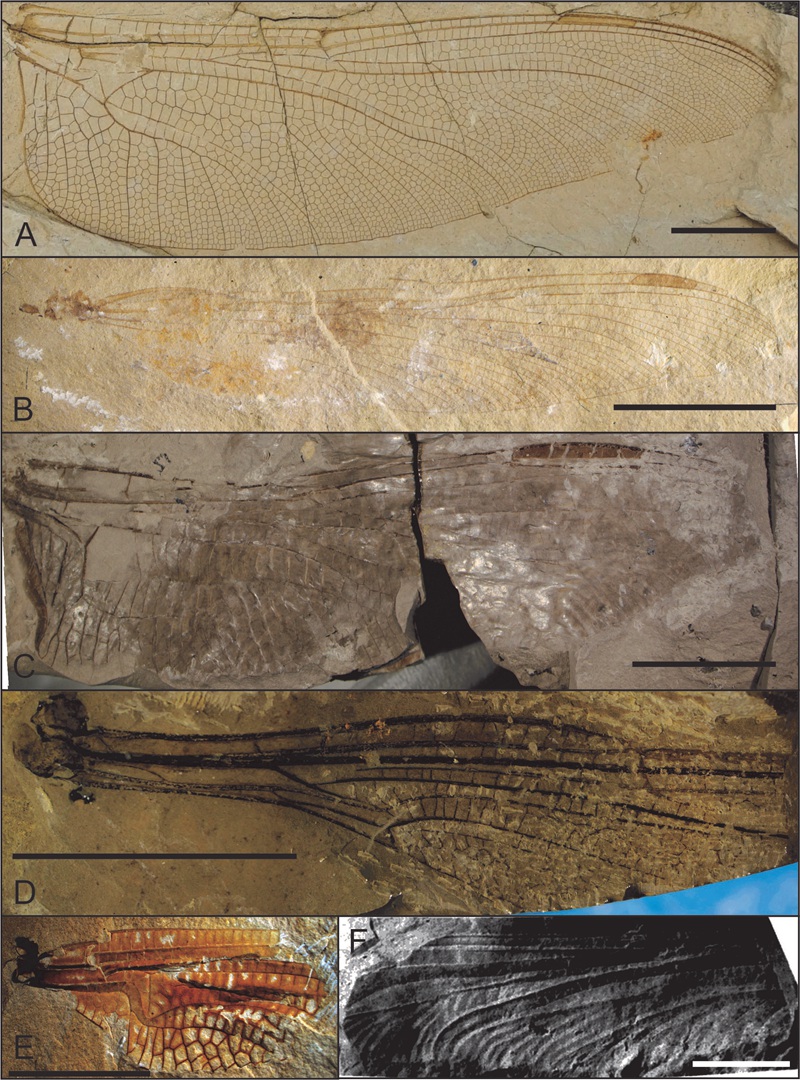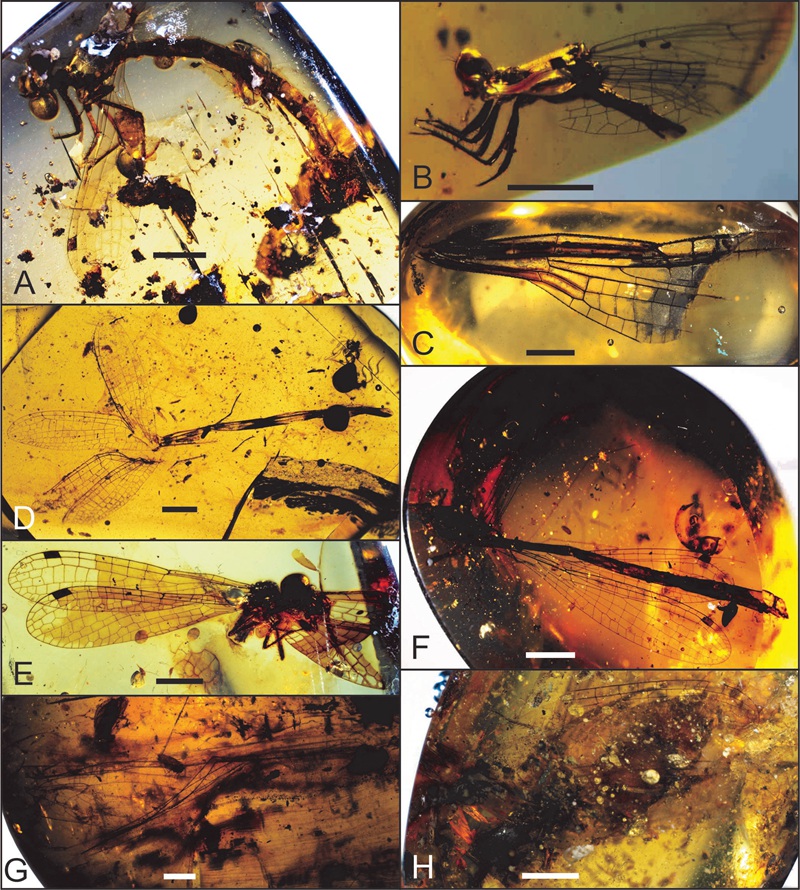The superorder Odonatoptera consists of the extinct orders Geroptera and Protodonata, and the recent order Odonata. Odonatoptera belongs to medium-large insect, is the pioneer conquering the sky, and has been the giant insect with the wing spans over half meter. The dragonfly has strong fly ability, fast migration, wide distribution, which can help us correlate the strata and evaluate the influence of the vital geological and ecological events on insect evolution. Due to the large size and few number, rare dragonflies can be preserved as the fossil records.
Recently, the Mesozoic research group of our institute cooperates with The University of Hong Kong, and mades a detailed study on the Mesozoic Odonatoptera. The specimens were from the Triassic of Shaanxi, the Jurassic of Xinjiang, the Lower Cretaceous of Inner Mongolia, western Liaoning, and Cretaceous Burmese amber. 11 new species, 6 new genera and 1 new subfamily were established relating to 11 families. This research can contribute to the correlation of Chinese non-marine strata, and providing new evidence for the origination, evolution and radiation of dragonflies.
Represented findings are as follows:
1. The first Triassic Protodonata from China. Although abundant dragonfly fossils have been reported from the Middle Jurassic–Lower Cretaceous, no Triassic dragonflies have been recorded. In the past years, we unearthed one protodonatan dragonfly, representing the first discovery. The fossil genera has been previously recorded in the Madygen Formation of Kyrgyzstan. Combined with the palaeontological and geochronological evidence, the age of the Tongchuan Formation is considered to be Anisian–Early Carnian, and the insect-bearing layers are considered to be Ladinian.
2. The first earliest Jurassic Odonata. The fossil was collected from the middle part of the Upper Triassic-Lower Jurassic Badaowan Formation. The similar damsel-dragonfly was initially described from the Lower Jurassic (Lower Lias, lowermost Sinemurian) of Dorset, England, reflecting the close relationship between these two insect assemblages. The latitude of the Junggar Basin during the T-J interval was considered to be around 60° N, while England was located at 30–40° N, suggesting a long distance between the two areas. The appearance of the damsel-dragonfly in two localities probably reflect a weak influence of the end-Triassic extinction on damsel-dragonflies or a quick dispersal of damsel-dragonflies during the earliest Jurassic.
3. Diversity of extinct family Stenophlebiidae. Stenophlebiidae has been found widely distributed in the Jurassic-Cretaceous strata of Germany, Spain, England, France, China, Mongolia and Kazakhstan. Until now, only one unquestioned stenophlebiid damsel-dragonfly has been recorded from the Lower Cretaceous Yixian Formation of the Liutiaogou outcrop in Inner Mongolia. Liaostenophlebia yixianensis Zheng et al., 2016 is a new genus of this family. Except S. karatavica from the Jurassic of Kazakhstan, Stenophlebia is known by several species from the Upper Jurassic of Europe. The new species S. liaoxiensis Zheng et al., 2016, from the Lower Cretaceous of Liaoning, extends the range both stratigraphically and geographically of this extinct dragonflies.
4、New dragonfly and damselfly from mid-Cretaceous Burmese amber. The study of the insect inclusions in Burmese amber is about a century old, but the odonatans were just from 2010. In the recent years, as more insect inclusions discovered from Burmese amber, three suborders of the recent Odonata were reported represented by Zygoptera (damselfly).
The main findings include: the second true dragonfly from Cretaceous amber; the first Hemiphlebiidae may be the most common damselfly in Burmese amber with over 50 specimens having been observed; the earliest fossil platystictid damselfly puts the origin of Platystictidae to at least mid-Cretaceous in tropical forest; the first fossil Perilestidae; a new species of Platycnemididae; a new subfamily and two new genera of the extinct family Dysagrionidae with unique discoidal cell contributing to the evolution of damselfly wings.
The study were published (including accepted) in the following geological journals: Geological Magazine, Journal of Paleontology, Cretaceous Research, Proceedings of the Geologists' Association, Comptes Rendus Palevol and Alcheringa.
Related information of these research:
Zheng, D.R., Wang, B., Chang, S-C. (in press). Palaeodisparoneura cretacica sp. nov., a new damselfly (Odonata: Zygoptera: Platycnemididae) from mid-Cretaceous Burmese amber. Comptes Rendus Palevol, doi: 10.1016/j.crpv.2016.08.005.

Figure 1. Mesozoic Odonatoptera from north China, scale bars = 10 mm. A, Sinaktassia tangi Lin, Nel & Huang, 2010; B, Stenophlebia liaoningensis Zheng et al., 2016; C, Dorsettia sinica Zheng et al., 2016; D, Zygophlebia tongchuanensis Zheng et al., 2016; E, Liaostenophlebia yixianensis Zheng et al., 2016; F, Sinostenophlebia zhanjiakouensis Hong, 1984.

Figure 2. Odonata from mid-Cretaceous Burmese amber, scale bars = 2 mm. A–B, Burmahemiphlebia zhangi Zheng et al., 2016; C, Palaeodysagrion cretacicus Zheng et al., 2016; D, Palaeodisparoneura cretacica Zheng et al., 2016; E, Burmadysagrion zhangi Zheng, Wang and Nel, 2016; F, Mesosticta electronica Zheng et al., 2016; G, Cretagomphaeschnaoides jarzembowskae Zheng et al., 2016; H, Palaeoperilestes electronicus Zheng et al., 2016.
Download:
